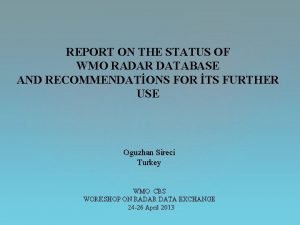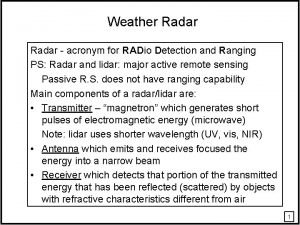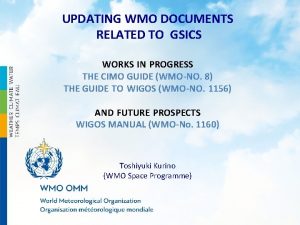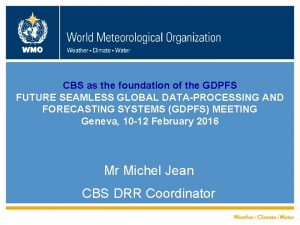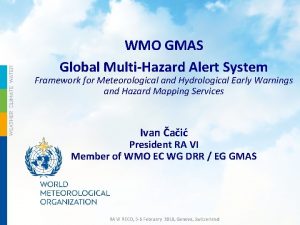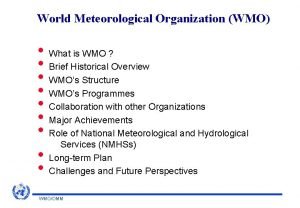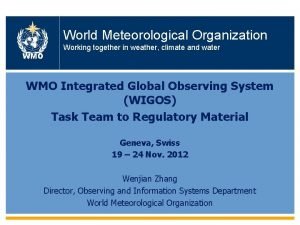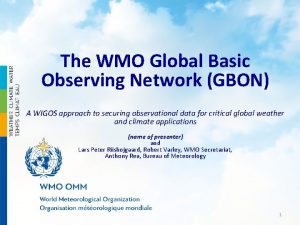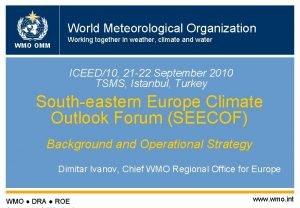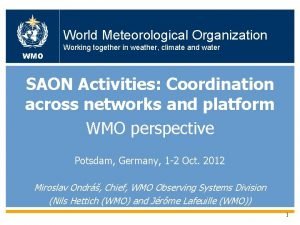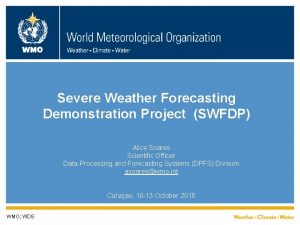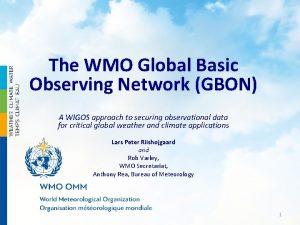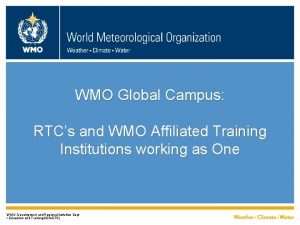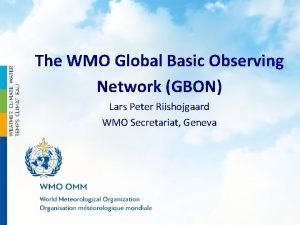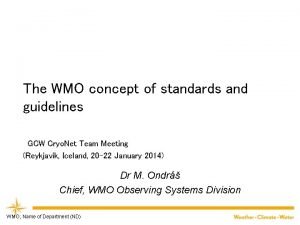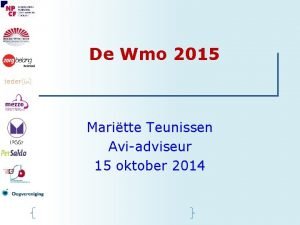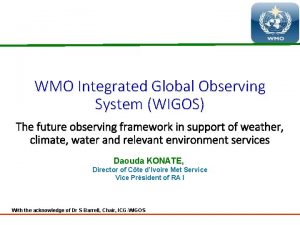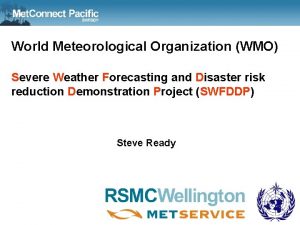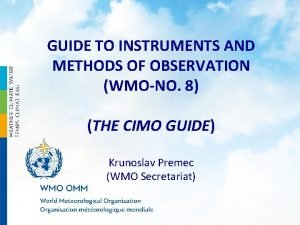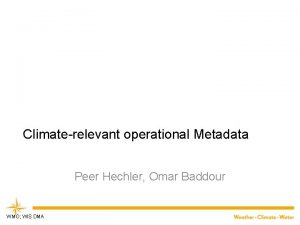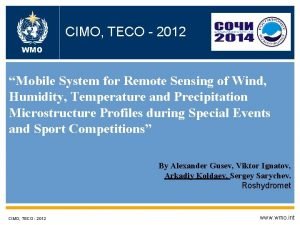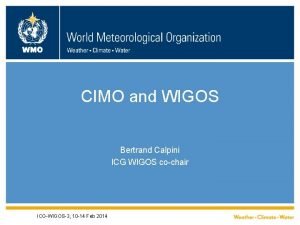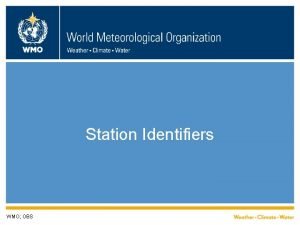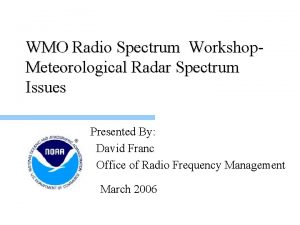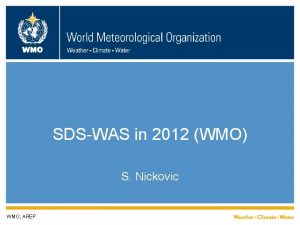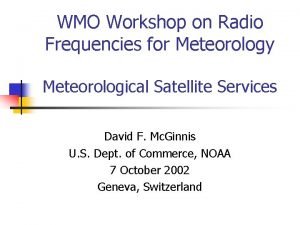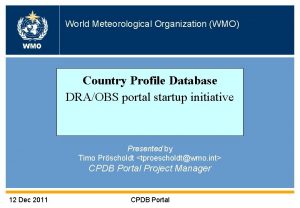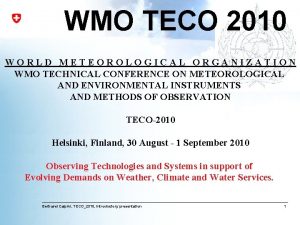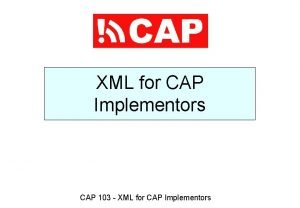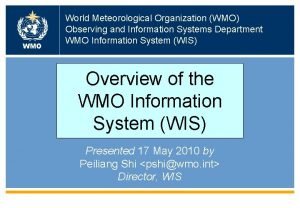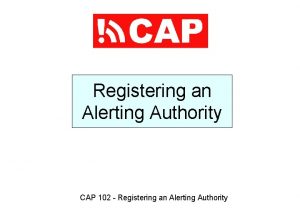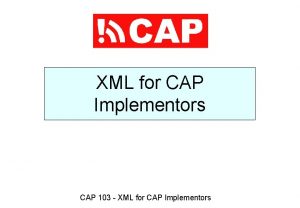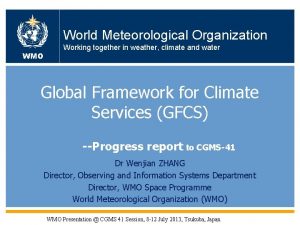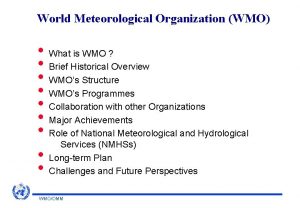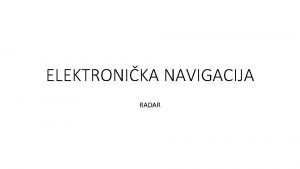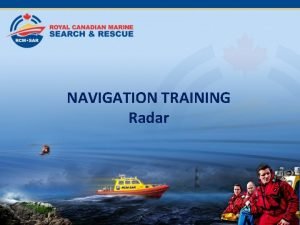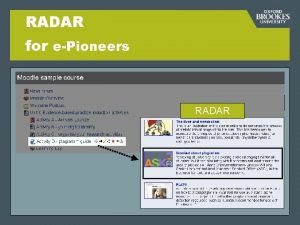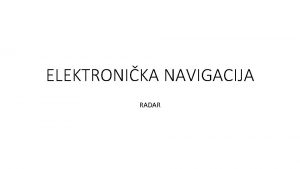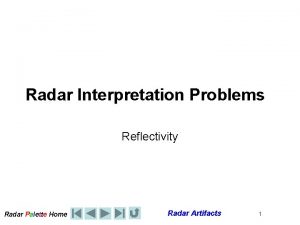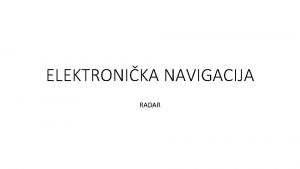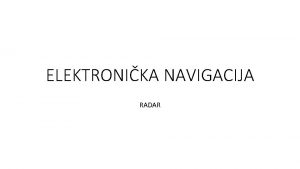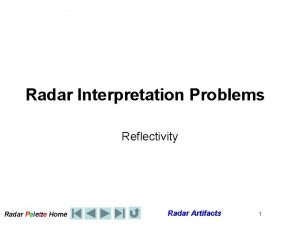WMO Radio Spectrum Workshop Meteorological Radar Spectrum Issues






























- Slides: 30

WMO Radio Spectrum Workshop. Meteorological Radar Spectrum Issues Presented By: David Franc Office of Radio Frequency Management March 2006

Purpose Provide background information on, and current status of radio frequency issues that may impact global meteorological radar operations, and identify items for consideration by Members l This section of the workshop covers radars used for monitoring the atmosphere with the exception of Wind Profiler Radars l 2

Outline l Meteorological radar bands l ITU-R Recommendations l Spectrum issues – WRC-2007 Agenda Item 1. 3 – WRC-2007 Agenda Item 1. 4 – JRG-1 A/1 C/8 B – Work of Working Party 8 B (WP 8 B) l Important points 3

Meteorological Radar Bands

Meteorological Radar Bands l Three allocations exist in the Radio Regulations specifically identified for meteorological radars – 2700 -2900 MHz- ground based radars – 5600 -5650 MHz- ground based radars – 9300 -9500 MHz- ground based and airborne radars l Depending on type of use, radionavigation and radiolocation bands can also be used 5

Need for 3 Frequency Bands? System cost, complexity and operating range are all limitations that can be addressed through additional engineering and funding l Severe weather performance is a physical limitation that can not be addressed through additional engineering or funding l Severe weather performance is dependent upon frequency of operation l 6

Severe Weather Performance Limitation l The ability of a meteorological radar to measure high wind speeds at its outer operational range is limited by the frequency of operation Maximum velocity Maximum range Frequency v * r 1/f Therefore, as frequency increases, the maximum range or maximum observable velocity, or both must decrease 7

Performance Comparison of Bands System Cost: System Complexity: Operating Range: Severe Weather Performance: Highest- 2700 -2900 MHz Lowest- 9300 -9500 MHz ~450 km- 2700 -2900 MHz ~200 km- 5600 -5650 MHz <75 km- 9300 -9500 MHz Highest- 2700 -2900 MHz Lowest- 9300 -9500 MHz 8

ITU-R Meteorological Radar Recommendations

Technical and Operational Characteristics l The following Recommendations provide technical and operational characteristics of meteorological radars – – l ITU-R M. 1464: 2700 -2900 MHz ITU-R M. 1460: 2900 -3100 MHz ITU-R M. 1638: 5250 -5850 MHz ITU-R M. [8 B. 8 -10 GHZ]: 8 -10 GHz* Use: Information for conducting sharing studies *- Still under development within WP 8 B 10

ITU-R M. 1461 l Content: General procedures for conducting sharing studies with radars l Use: Guidance to conduct sharing studies l M. 1461 is very generic and does not address the specific needs of meteorological radars – Companion recommendation on meteorological radars under development within WP 8 B 11

Wind Profiler Technical and Operational Characteristics l The following provide technical and operational characteristics of Wind Profiler Radars – ITU-R M. 1226: Around 50 MHz – ITU-R M. 1085: Around 400 MHz – ITU-R M. 1227: Around 1000 MHz Use: Information for conducting sharing studies l In need of review and update l 12

Current Spectrum Issues

Current Spectrum Issues l WRC Agenda Item 1. 3 l WRC Agenda Item 1. 4 l JRG-1 A/1 C/8 B: Radar emission masks l Working Party 8 B – Compatibility analysis procedures – Protection criteria – Statistics-based compatibility analysis 14

WRC-Agenda Item 1. 3 l Objective: – Upgrade radiolocation service (radars) to primary status in 9300 - 9500 MHz – Earth exploration satellite service (EESS) allocation extension into 9300 -9500 MHz l Impact: – Radiolocation upgrade raises the status of meteorological radars to primary status – Extension of EESS in 9300 -9500 MHz could impact meteorological radars 15

Agenda Item 1. 3 (continued) l Status: – Studies underway to evaluate impact of EESS to meteorological radars in 9300 -9500 MHz – EESS extension could be placed in 9800 -10000 MHz- not preferred approach l Advantages: – EESS could have meteorological applications – Radiolocation upgrade important for meteorological radar operations 16

Agenda Item 1. 4 l Objective: – Consider frequency related issues associated with IMT-2000 and IMT Advanced • IMT-2000: Third generation (3 G) mobile telecommunications • IMT Advanced: Fourth generation mobile telecommunications l Impact: – 2700 -2900 MHz has been identified as a candidate band for Agenda Item 1. 4 – Use of band for IMT-2000 or IMT Advanced will cause loss of spectrum for meteorological operations 17

Agenda Item 1. 4 (continued) l Status: – WRC-2000: studies on impact to existing users (radars) were incomplete- created preliminary WRC-2007 Agenda Item – WRC-2003: studies showed IMT-2000 and existing systems were incompatible - Agenda Item deleted from WRC-2007 agenda – Studies now being updated for re-submission to ITU-R l Advantages: – None to meteorological operations 18

JRG-1 A/1 C/8 B l Objective: – Develop ITU-R Recommendation(s) on radar emission masks – Emission masks define the required roll-off from the fundamental frequency l Impact: – Could place design limitations on radar technology l Advantages: – Limit adjacent channel and adjacent band interference – Increased spectrum efficiency 19

JRG-1 A/1 C/8 B Emission Mask Example #1 Source: JRG-1 A/1 C/8 B Doc. 52 20

JRG-1 A/1 C/8 B Emission Mask Example #2 Source: JRG-1 A/1 C/8 B Doc. 52 21

JRG-1 A/1 C/8 B Work Plan Define necessary 20 d. B and 40 d. B bandwidth for various radar technologies l Define roll-off beyond 40 d. B bandwidth- 20 d. B or 40 d. B per decade l Need emission data and characteristics for example radars l – Ensure realistic limits are established – Identify technology that needs different limits 22

Work of Working Party 8 B (WP 8 B) l Compatibility analysis procedures l Statistics-based compatibility analysis l Protection criteria 23

Compatibility Analysis Procedures l Methods used for evaluating impact of sharing spectrum between radars and other services l Meteorological radars are different than other radars l WP 8 B developing a document specific to Meteorological Radars 24

Statistics-Based Compatibility Analysis WP 8 B is studying ways to use statistical analysis to improve the accuracy of sharing studies l May allow for use of more accurate propagation models l Could require radar operators to accept interference for short periods of time l – Exceedance value greater than 0% associated with Protection Criteria 25

Radar Protection Criteria- the maximum interference level threshold for protection of radar l Protection criteria for meteorological radars dependent on l – Base product accuracy – Minimum usable signal-to-noise ratio – Radar receiver noise level l Current meteorological radar protection criteria not clearly defined in the ITU 26

Important Points

Important Points l WRC-2007 Agenda Item 1. 3 – Radiolocation upgrade benefits meteorological radar operations – EESS extension into 9300 - 9500 MHz • May impact meteorological radars • may also benefit meteorological operations l WRC-2007 Agenda Item 1. 4 – The band 2700 -2900 MHz inappropriate for use by IMT-2000 and IMT Advanced 28

Important Points (continued) l JRG-1 A/1 C/8 B – Should be followed to ensure emission masks do not overly restrict radar design l Other Work of WP 8 B – Follow discussions on compatibility analysis procedures, including use of statistics to ensure meteorological radars will be protected 29

Important Points (continued) l Work with your National Spectrum Regulators – Raise their awareness of spectrum needs for meteorological radar operations Participate in the meetings of the ITU if resources allow l Ensure your radar system characteristics and requirements are documented in ITU -R recommendations l 30
 Exeter radar
Exeter radar Delay line canceller in radar
Delay line canceller in radar Limitations of mti radar
Limitations of mti radar Radar stands for radio detection and
Radar stands for radio detection and Awin support
Awin support Electromagnetic wave spectrum
Electromagnetic wave spectrum D orbital shape
D orbital shape Absorption spectrum
Absorption spectrum Wmo regional training centres
Wmo regional training centres Cimo guide wmo
Cimo guide wmo Gdpfs
Gdpfs Gmas wmo
Gmas wmo What is wmo
What is wmo Wmo
Wmo Gbon wmo
Gbon wmo Wmo omm
Wmo omm Wmo omm
Wmo omm Wmo severe weather
Wmo severe weather Wmo gbon
Wmo gbon Ipcc wmo
Ipcc wmo Wmo global campus
Wmo global campus Wmo gbon
Wmo gbon Wmo
Wmo Wmo
Wmo Wmo wigos
Wmo wigos Wmo severe weather
Wmo severe weather Wmo cimo guide
Wmo cimo guide Omar baddour
Omar baddour Wmo cimo
Wmo cimo Bertrand calpini
Bertrand calpini Wmo station identifiers
Wmo station identifiers
